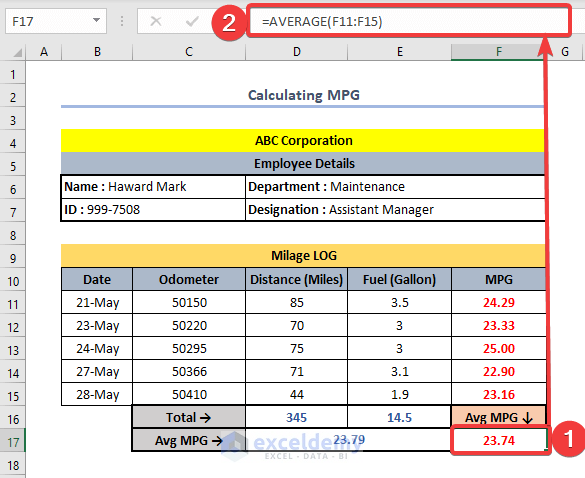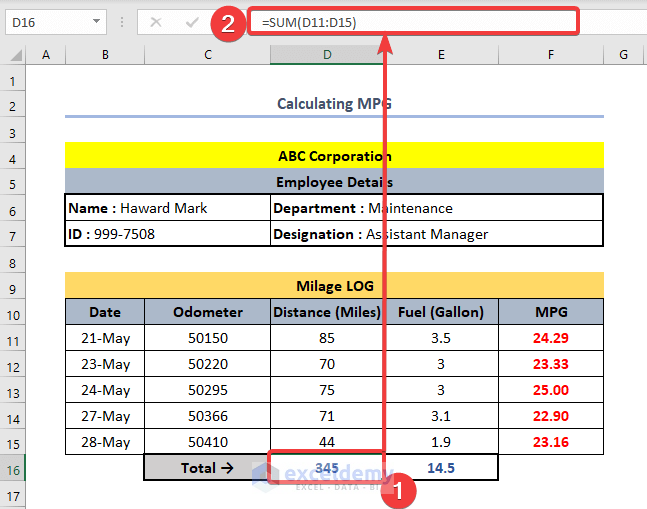
Calculating MPG Manually: A Comprehensive Guide to Fuel Efficiency
In an era of rising fuel costs and growing environmental consciousness, understanding your vehicle’s fuel efficiency is more important than ever. While modern cars often feature onboard computers that provide MPG (miles per gallon) readings, these figures can sometimes be inaccurate or unreliable. Calculating MPG manually is a simple yet powerful way to gain a true understanding of your vehicle’s fuel consumption, allowing you to make informed decisions about driving habits, maintenance, and even vehicle selection.
Why Calculate MPG Manually?
Before diving into the "how," let’s explore the "why." There are several compelling reasons to calculate your MPG manually:
- Accuracy: Onboard computer readings can be affected by various factors, including tire size, driving style, and sensor calibration. Manual calculations provide a more direct and reliable measure of fuel efficiency.
- Early Problem Detection: A sudden drop in MPG can be an early indicator of mechanical issues, such as a faulty oxygen sensor, a clogged air filter, or even tire underinflation. Monitoring MPG manually allows you to catch these problems early, potentially saving you money on repairs and fuel in the long run.
- Driving Habit Awareness: By tracking your MPG under different driving conditions (city vs. highway, light vs. heavy traffic), you can gain insights into how your driving style affects fuel consumption. This awareness can motivate you to adopt more fuel-efficient driving habits.
- Vehicle Comparisons: Manual MPG calculations provide a standardized way to compare the fuel efficiency of different vehicles, regardless of their onboard computer systems. This is especially useful when considering a new or used car purchase.
- Empowerment: Understanding your vehicle’s fuel efficiency empowers you to make informed decisions about your transportation choices, contributing to both financial savings and environmental responsibility.
The Basic Formula
The formula for calculating MPG is remarkably straightforward:
MPG = Miles Driven / Gallons of Fuel Used
To calculate MPG manually, you’ll need to gather two key pieces of information:
- Miles Driven: The number of miles you’ve driven since your last fill-up.
- Gallons of Fuel Used: The amount of fuel (in gallons) required to refill your tank.
Step-by-Step Guide to Calculating MPG Manually
Here’s a detailed step-by-step guide to ensure accurate MPG calculations:
-
Fill Up Your Tank Completely: Start with a full tank of gas. It’s crucial to fill the tank until the pump clicks off automatically. Avoid topping off the tank, as this can lead to inaccurate readings and potential fuel spillage. Note the exact odometer reading at the time of fill up. You can write this down in a notebook, or use an app on your smartphone.
-
Drive as Usual: Drive your vehicle as you normally would, going about your daily routine. The key is to drive a representative mix of city and highway miles to get an accurate overall MPG reading.
-
Refuel and Record: When your fuel tank is nearing empty (but not completely empty!), return to the same gas station and pump (if possible). Fill the tank completely again, stopping when the pump clicks off automatically. Note the exact number of gallons it takes to refill the tank. Also, record the current odometer reading.
-
Calculate Miles Driven: Subtract the initial odometer reading (from step 1) from the final odometer reading (from step 3). This will give you the total number of miles you drove during the period.
Miles Driven = Final Odometer Reading - Initial Odometer Reading -
Apply the MPG Formula: Divide the miles driven (from step 4) by the gallons of fuel used (from step 3). This will give you your vehicle’s MPG for that particular driving cycle.
MPG = Miles Driven / Gallons of Fuel Used
Example Calculation
Let’s illustrate with an example:
- Initial Odometer Reading: 25,000 miles
- Final Odometer Reading: 25,350 miles
- Gallons of Fuel Used: 12 gallons
- Miles Driven = 25,350 – 25,000 = 350 miles
- MPG = 350 miles / 12 gallons = 29.17 MPG
In this example, the vehicle achieved approximately 29.17 miles per gallon during that driving cycle.
Tips for Accurate MPG Calculations
To ensure the most accurate MPG readings, consider the following tips:
- Consistency is Key: Always fill up at the same gas station and pump (if possible). Different pumps can have slightly different calibration, which can affect the accuracy of your readings.
- Avoid Topping Off: As mentioned earlier, avoid topping off your fuel tank after the pump clicks off. This can lead to inconsistent readings and potential fuel spillage.
- Use the Same Fuel Grade: Stick to the same fuel grade (e.g., regular, mid-grade, premium) for each fill-up. Different fuel grades can have slightly different energy content, which can affect MPG.
- Track Over Multiple Fill-Ups: Don’t rely on a single MPG calculation. Track your MPG over several fill-ups to get a more accurate average.
- Consider Driving Conditions: Be aware of the driving conditions during each cycle. Factors like city vs. highway driving, traffic congestion, and weather conditions can all affect MPG.
- Maintain Your Vehicle: Regular maintenance, such as changing air filters, keeping tires properly inflated, and performing routine engine tune-ups, can significantly improve fuel efficiency.
- Use a Spreadsheet or App: Use a spreadsheet program (like Microsoft Excel or Google Sheets) or a dedicated MPG tracking app to record your data and calculate MPG automatically. This can save you time and effort.
- Be Mindful of Load: Hauling heavy loads or towing trailers will significantly reduce your MPG. Be sure to account for this when interpreting your MPG readings.
- Check Tire Pressure: Underinflated tires increase rolling resistance, which reduces fuel efficiency. Check your tire pressure regularly and inflate them to the recommended level.
- Avoid Aggressive Driving: Aggressive driving habits, such as rapid acceleration and hard braking, can significantly reduce MPG. Drive smoothly and anticipate traffic conditions to maximize fuel efficiency.
Troubleshooting Unexpected MPG Changes
If you notice a sudden or significant drop in your MPG, it’s important to investigate the potential causes. Here are some common issues to consider:
- Mechanical Problems: A faulty oxygen sensor, a clogged air filter, worn spark plugs, or a malfunctioning catalytic converter can all reduce fuel efficiency. Have your vehicle inspected by a qualified mechanic to diagnose and repair any mechanical issues.
- Tire Problems: Underinflated tires or misaligned wheels can increase rolling resistance and reduce MPG. Check your tire pressure regularly and have your wheels aligned as needed.
- Fuel Leaks: Check for any signs of fuel leaks around the fuel tank, fuel lines, and fuel injectors. Fuel leaks can be dangerous and can significantly reduce MPG.
- Driving Habits: Review your driving habits to see if you’ve been driving more aggressively or encountering more traffic congestion than usual.
- Weather Conditions: Cold weather can reduce MPG, as engines take longer to warm up and air density is higher.
Conclusion
Calculating MPG manually is a valuable skill for any vehicle owner. It provides a more accurate and insightful understanding of fuel efficiency than relying solely on onboard computer readings. By following the steps outlined in this guide and tracking your MPG over time, you can gain valuable insights into your vehicle’s performance, driving habits, and potential mechanical issues. This knowledge empowers you to make informed decisions that can save you money on fuel, reduce your environmental impact, and keep your vehicle running smoothly for years to come.
